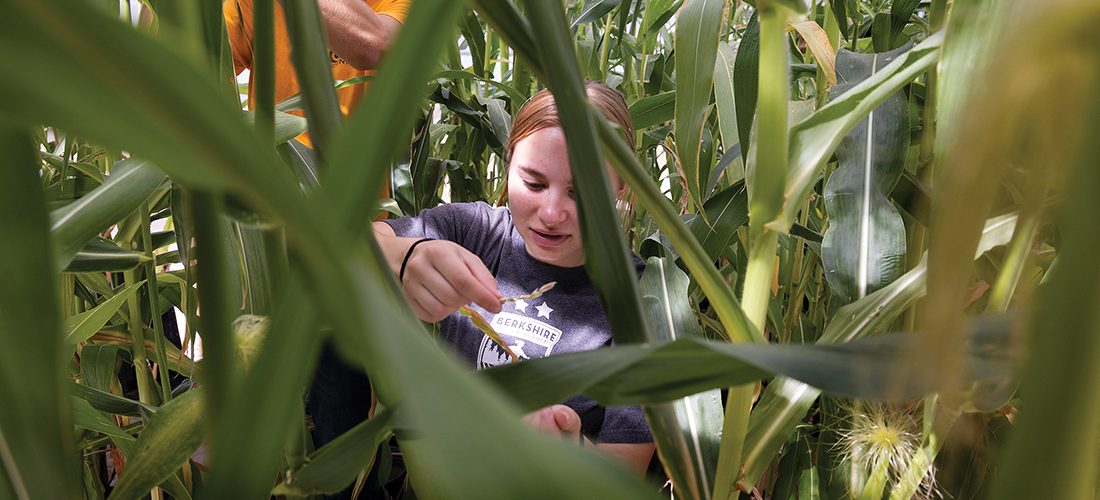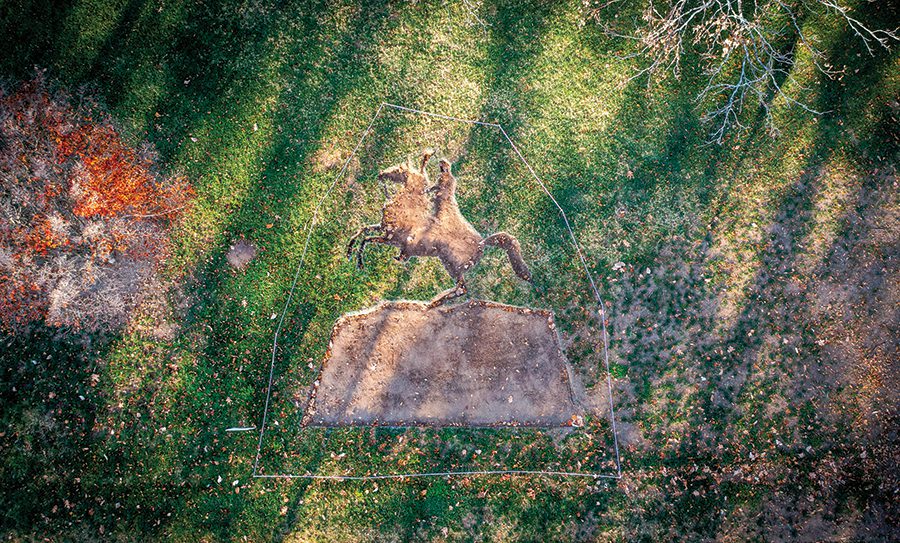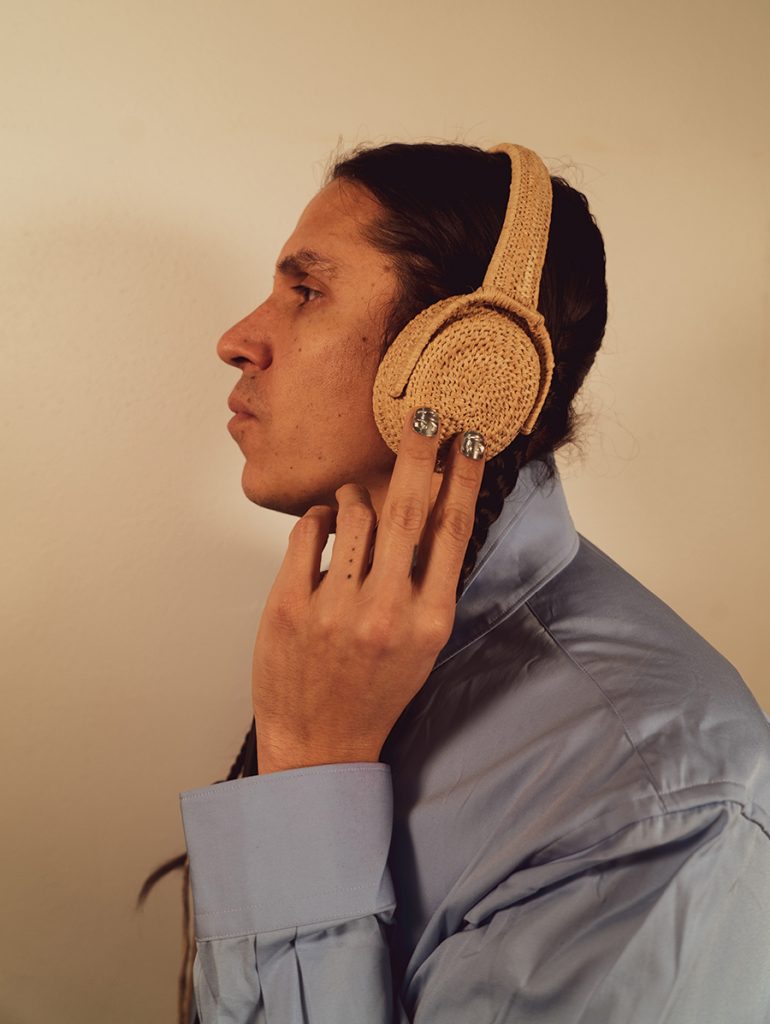Planting possibility
July 29, 2022

A Davidson College art installation encourages conversation about the history of the Catawba Nation’s ancestral land — and reintroduces an ancient crop.
by Vanessa Infanzon
Last November, the shape of President Andrew Jackson sitting astride a horse was dug into the dirt close to the corner of Griffith and Main streets in downtown Davidson. The hollowed silhouette was the first element of “Unshadowed Land,” a yearlong immersive art installation led by Tlingit and Unangaxˆ (indigenous people from the Aleutian Islands in Alaska) artist Nicholas Galanin.
The excavation, adjacent to Davidson College’s Katherine and Tom Belk Visual Arts Center, mimicks the bronze statue in Washington D.C.’s Lafayette Square. The statue was erected in 1853 as a tribute to the seventh president of the United States, who was born in the Waxhaws, a region between the Carolinas.
In recent years, people have contested the statue, asking for it to be removed because of Jackson’s decision to sign the Indian Removal Act in 1830, which led to the march known as the Trail of Tears. The monument still stands even after protesters attempted to bring it down last year.
Galanin is known for “Shadow on the Land,” a 2020 archeological excavation based on the shadow of the Captain James Cook statue in Australia. Like “Unshadowed Land,” the work explores the effects of settler colonization. The current installation is the next iteration, a generative piece that focuses on the strengths of the indigenous communities and is a testament to their resiliency, Galanin says. “We have no shortage of colonial monuments,” he says. “Not all these histories represent heroes to a large amount of the community.”
Due to Covid restrictions, Galanin couldn’t travel to and from his home in Alaska to supervise the installation of “Unshadowed Land.” He supplied the concept and the imagery. The Davidson College community partnered with the Catawba Nation to implement the steps. In November, Galanin’s templates, all to the scale of the original Jackson statue, were used to cut the shape into the ground.

The intention of the outdoor installation is to encourage conversation and questions about the history of the Catawba Nation’s ancestral land, which once stretched from Morganton to Rock Hill, S.C., including where Davidson College stands. “Unshadowed Land” is a response to the research of the college’s past and its treatment of the indigenous people who lived on the land. “Indigenous communities across the globe deal with a lot of similar forms of oppression, from displacement to loss of language, assimilation,” Galanin says. “We’re also fighting for access to our land, our relationship to that land through hunting and fishing.”
DeLesslin George-Warren or “Roo,” had worked with Davidson College on other projects before “Unshadowed Land.” This one was a good fit for him: Roo is a citizen of Catawba Nation and an artist whose practice includes performance art, installations, community education and food sovereignty. At the National Portrait Gallery in Washington, D.C., Roo gave weekly tours three months prior to the 2016 elections. He called his work “The Indigenous Core of Discovery.” He always started at a larger-than-life-sized portrait of Jackson. “I was trying to unsettle our understanding of the relationships between presidents and indigenous communities,” he says.
Catawba corn was grown until the 1990s; the seeds and knowledge were lost. As “Unshadowed Land” developed, Roo connected with David Shields, an English professor at the University of South Carolina known for his interest in heritage seeds. “Dr. Shields attended a presentation by the N.C. Extension Office about the results of some corn trials they were doing,” Roo says. “Lial Flint Corn was the one Dr. Shields thought might be related to our traditional corn, based on historical and archaeological records.”

photograph by Merritt Johnson
Shields sent Roo some Lial Flint Corn seeds. Since this project, the Catawba have been expanding their capacity to provide seeds for themselves. “Across the Americas for millennia and around the world for the last few hundred years, corn has been celebrated for its incredible beauty, flavor, vigor and adaptability,” Roo says. “Reclaiming our kus (corn) and relearning the accompanying practices is bringing us back into the rhythm of planting, growing, harvesting, seed-saving and feeding the people that sustained Catawbas for at least 6,000 years. With any luck, it will sustain us for another few millennia at least.”
In February, a group of students and citizens of the Catawba Nation filled in the hole with compost. This spring, Lial Flint Corn seeds were planted inside the excavated space and on The Farm at Davidson, five minutes from the main campus. “The goal is to grow enough corn to reintroduce this variety to gardens across the Catawba Nation,” says Rose Stremlau, associate professor in the history and gender and sexuality studies departments at Davidson College. “If we succeed, we will be able to return this corn to the Catawba, in mass, and hopefully continue this relationship in other ways that are productive, respectful and generative for all involved.” SP
The final cycle in “Unshadowed Land” is the fall harvest. It will be accompanied by events, lectures and other special activities at Davidson College. For more information, check: davidsoncollegeartgalleries.org/events.